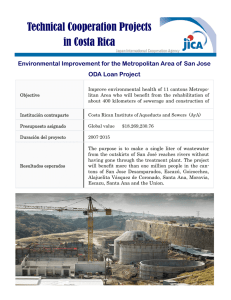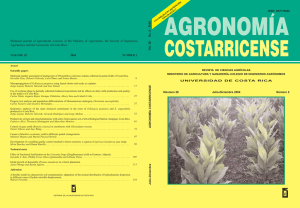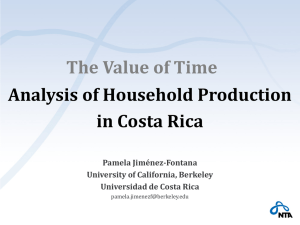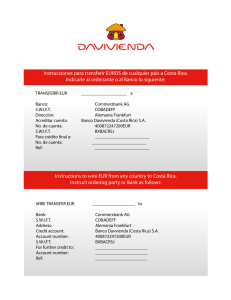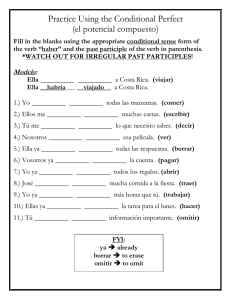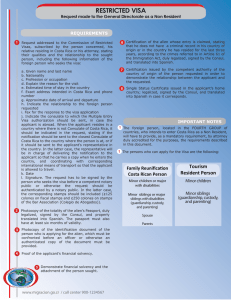Œwiętojańska J.
Anuncio
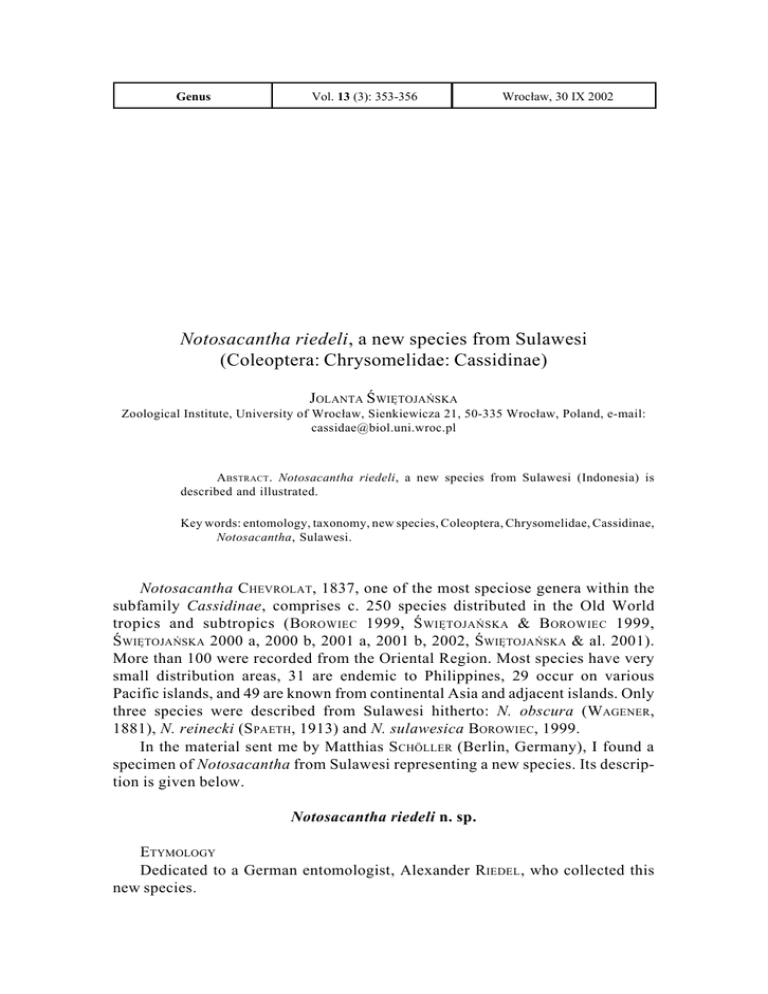
Genus Vol. 13 (3): 353-356 Wroc³aw, 30 IX 2002 Notosacantha riedeli, a new species from Sulawesi (Coleoptera: Chrysomelidae: Cassidinae) JOLANTA ŒWIÊTOJAÑSKA Zoological Institute, University of Wroc³aw, Sienkiewicza 21, 50-335 Wroc³aw, Poland, e-mail: [email protected] ABSTRACT. Notosacantha riedeli, a new species from Sulawesi (Indonesia) is described and illustrated. Key words: entomology, taxonomy, new species, Coleoptera, Chrysomelidae, Cassidinae, Notosacantha, Sulawesi. Notosacantha CHEVROLAT, 1837, one of the most speciose genera within the subfamily Cassidinae, comprises c. 250 species distributed in the Old World tropics and subtropics (BOROWIEC 1999, Œ WIÊTOJAÑSKA & B OROWIEC 1999, Œ WIÊTOJAÑSKA 2000 a, 2000 b, 2001 a, 2001 b, 2002, ŒWIÊTOJAÑSKA & al. 2001). More than 100 were recorded from the Oriental Region. Most species have very small distribution areas, 31 are endemic to Philippines, 29 occur on various Pacific islands, and 49 are known from continental Asia and adjacent islands. Only three species were described from Sulawesi hitherto: N. obscura (WAGENER, 1881), N. reinecki (S PAETH, 1913) and N. sulawesica BOROWIEC, 1999. In the material sent me by Matthias SCHÖLLER (Berlin, Germany), I found a specimen of Notosacantha from Sulawesi representing a new species. Its description is given below. Notosacantha riedeli n. sp. ETYMOLOGY Dedicated to a German entomologist, Alexander RIEDEL , who collected this new species. 354 JOLANTA ŒWIÊTOJAÑSKA DIAGNOSIS Notosacantha riedeli belongs to the species group with body short-oval to circular, principal tubercle with at least three costae, at least dorsal costa complete, basal tubercle not bent outwards, without transverse costa running from basal tubercle to humeral tubercle, apical costa distinct and complete, anterior and posterior branch of dorsal costa at principal tubercle converging in different points, and explanate margin of elytra with dark spots. This group also includes N. flavicornis (S P.) described from “India Orientalis” (probably from one of Indonesian island), N. sumbawaensis ŒWIÊT . & BOR. from Sumbawa, N. reinecki (S P.) from Sulawesi, N. sulawesica BOR. from Sulawesi, N. weyersi (SP .) from Sumatra and Java, N. nigrodorsata CHEN & ZIA from S China and Laos, N. vicaria (S P.) from India, Ceylon and Andaman, and N. kantneri ŒWIÊT . et BOR. from Thailand. N. riedeli differs from all its relatives in the presence of incomplete postapical costa. The character is rare within the genus and in Oriental species occurs only in N. kinabaluensis ŒWIÊT . from Borneo, belonging to another species group with anterior and posterior branch of dorsal costa converging at the principal tubercle in the same point. N. kinabaluensis differs also in complete postapical costa (in N. riedeli not connected with costa ultima), antennal club stouter than in N. riedeli, black posterior half of elytra (mostly yellowish-brown in N. riedeli), and anterior branch of dorsal costa broken between basal and subbasal tubercle (in N. riedeli complete). The hitherto known species from Sulawesi differ in the following characters: N. obscura (WAGENER, 1881) in mostly reduced dorsal costae and elytral disc completely black, N. reinecki in long furca interna which is connected with lateral branch of principal tubercle (in N. riedeli furca interna is shortened, not connected with lateral branch of principal tubercle), and N. sulawesica in elytral disc with only costae, without distinct tubercles (N. riedeli has complete set of costae and tubercles). Both N. reinecki and N. sulawesica differ also in stout antennal club. DESCRIPTION Length: 6.7 mm, width: 5.4 mm, length of pronotum: 1.7 mm, width of pronotum: 4.3 mm, length/width ratio: 1.24, width/length ratio of pronotum: 2.52. Body short-oval, the widest in 2/5 body length (fig. 1). Head yellowish-brown, with yellowish frontal plate. Disc of pronotum yellow at top and yellowish-brown in punctate areas on sides and along base. Explanate margin of pronotum yellow. Scutellum yellow. Disc of elytra yellowish-brownishred with brownish-black principal and apical tubercles, lateral and sutural branch of principal tubercle, and apical costa. Explanate margin of elytra reddish, with slightly darker reddish-brown humeral and posterolateral spots, and well marked yellow “window”. Ventrites and legs yellow, antennae uniformly yellowish-brown. Head with moderately large frontal plate, its sides converging in triangle, apex with shallow cleft. NOTOSACANTHA RIEDELI, A NEW SPECIES FROM SULAWESI 355 Pronotum broad, with maximum width in 1/3 basal length, sides regularly rounded. Disc with small punctures placed in four shallow impressions: two in anterior part of sides and two along base. Explanate margin, except row of small and circular punctures placed close to margin, with moderately large and circular pores, disposed regularly. Some pores along border of disc slightly elongate. Anterior part of pronotal extreme margin serrate, sides only indistinctly crenulate. Base of elytra wider than base of pronotum. Elytral disc with complete set of costae and tubercles: principal tubercle the highest, basal tubercle slightly smaller, humeral, subbasal and apical tubercles the smallest, and postapical tubercle barely elevated (figs 1 and 2). Principal tubercle with four costae. Dorsal costa complete. Anterior and posterior branch of dorsal costa in the middle distinctly curved towards suture. Anterior and posterior branch of dorsal costa at the top of principal tubercle converging in different points. Sutural branch of principal tubercle 1-4. Notosacantha riedeli: 1 - dorsal view, 2 - lateral view, 3 - hind view, 4 - antenna 356 JOLANTA ŒWIÊTOJAÑSKA extending to second row of punctures. Lateral branch of principal tubercle complete, runs obliquely anterad, extending to eighth row of punctures. Apicosutural costa extending to first row of punctures. Apicolateral costa complete, with complete costa ultima and costa terminalis, and short furca interna and externa. Furca interna not connected with lateral branch of principal tubercle. Postapical tubercle with distinct but incomplete postapical costa, runs obliquely anterad but not connected with costa ultima (fig. 3). Humeral costa distinct, with highly elevated anterior half. Humeral tubercle distinct. Puncturation between costae moderately coarse, distance between punctures as wide as puncture diameter. Puncturation of explanate margin mostly circular, only on sides along border of disc slightly elongate, pale “window” punctate. Antennae slim with distinct 4-segmented club. Pedicel c.2.6 times longer than club. Second antennal segment slightly elongate, c. 1.8 times as long as wide, segment 8 longer than wide, segments 9, and 10 slightly wider than long (fig. 4). TYPE MATERIAL Holotype: “Indonesien, Sulawesi, Palu: Palolo Lindu-National Park, 25-27. VIII. 1990, leg Alexander Riedel” (preserved at the Department of Systematic Zoology and Zoogeography, Wroc³aw University, Wroc³aw, Poland). ACKNOWLEDGEMENT I would like to express my sincere thanks to M. SCHÖLLER (Berlin, Germany) for sending me the specimen of the new species. REFERENCES B OROWIEC, L., 1999. A world catalogue of the Cassidinae (Coleoptera: Chrysomelidae). Biologica Silesiae, Wroc³aw, 476 pp. ŒWIÊTOJAÑSKA , J., 2000 a. Five new species of Notosacantha CHEVROLAT from the Philippines (Coleoptera: Chrysomelidae: Cassidinae). Genus, 11: 205-217. —, 2000 b. Notosacantha multicostata, a new species from Madagascar (Coleoptera: Chrysomelidae: Cassidinae). Genus, 11: 593-596. —, 2001 a. Two new species of Notosacantha CHEVROLAT from Sumatra (Coleoptera: Chrysomelidae: Cassidinae). Genus, 12: 51-57. —, 2001 b. Four new species of Notosacantha C HEVROLAT from Borneo (Coleoptera: Chrysomelidae: Cassidinae). Genus, 12: 335-347. —, 2002. Notosacantha bezdeki, a new species from Laos (Coleoptera: Chrysomelidae: Cassidinae). Genus, 13: 39-42. ŒWIÊTOJAÑSKA , J., B OROWIEC, L. 1999.Two new species of Notosacantha CHEVROLAT from the Oriental region (Coleoptera: Chrysomelidae: Cassidinae). Genus, 10: 421-426.
